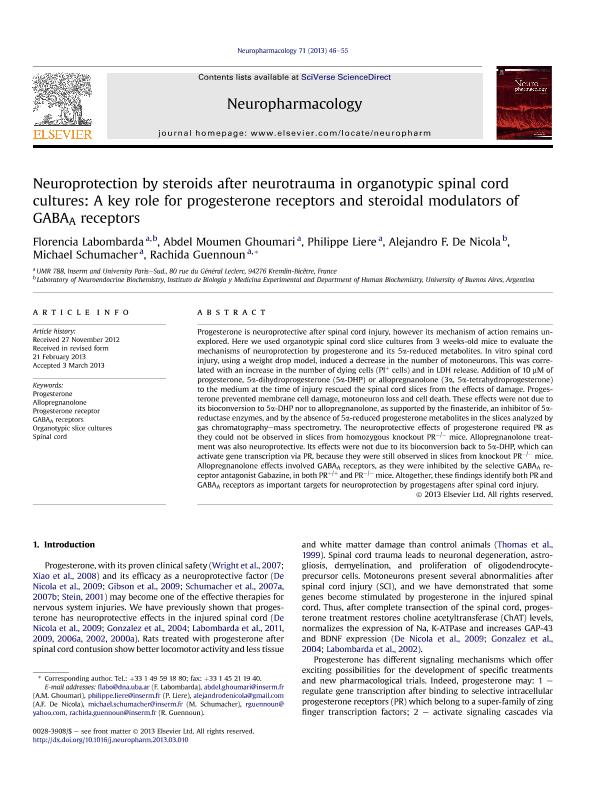Mostrar el registro sencillo del ítem
dc.contributor.author
Labombarda, Maria Florencia

dc.contributor.author
Ghoumari, Abdel Moumen
dc.contributor.author
Liere, Phillippe
dc.contributor.author
de Nicola, Alejandro Federico

dc.contributor.author
Schumacher, Michael

dc.contributor.author
Guennoun, Rachida

dc.date.available
2015-10-08T18:22:48Z
dc.date.issued
2013-08-31
dc.identifier.citation
Labombarda, Maria Florencia; Ghoumari, Abdel Moumen; Liere, Phillippe; de Nicola, Alejandro Federico; Schumacher, Michael; et al.; Neuroprotection by steroids after neurotrauma in organotypic spinal cord cultures: A key role for progesterone receptors and steroidal modulators of GABAA receptors; Elsevier; Neuropharmacology; 71; 31-8-2013; 46-55
dc.identifier.issn
0028-3908
dc.identifier.uri
http://hdl.handle.net/11336/2414
dc.description.abstract
Progesterone is neuroprotective after spinal cord injury, however its mechanism of action remains unexplored. Here we used organotypic spinal cord slice cultures from 3 weeks-old mice to evaluate the mechanisms of neuroprotection by progesterone and its 5α-reduced metabolites. In vitro spinal cord injury, using a weight drop model, induced a decrease in the number of motoneurons. This was correlated with an increase in the number of dying cells (PI+ cells) and in LDH release. Addition of 10 μM of progesterone, 5α-dihydroprogesterone (5α-DHP) or allopregnanolone (3α, 5α-tetrahydroprogesterone) to the medium at the time of injury rescued the spinal cord slices from the effects of damage. Progesterone prevented membrane cell damage, motoneuron loss and cell death. These effects were not due to its bioconversion to 5α-DHP nor to allopregnanolone, as supported by the finasteride, an inhibitor of 5α-reductase enzymes, and by the absence of 5α-reduced progesterone metabolites in the slices analyzed by gas chromatography–mass spectrometry. The neuroprotective effects of progesterone required PR as they could not be observed in slices from homozygous knockout PR−/− mice. Allopregnanolone treatment was also neuroprotective. Its effects were not due to its bioconversion back to 5α-DHP, which can activate gene transcription via PR, because they were still observed in slices from knockout PR−/− mice. Allopregnanolone effects involved GABAA receptors, as they were inhibited by the selective GABAA receptor antagonist Gabazine, in both PR+/+ and PR−/− mice. Altogether, these findings identify both PR and GABAA receptors as important targets for neuroprotection by progestagens after spinal cord injury,
dc.format
application/pdf
dc.language.iso
eng
dc.publisher
Elsevier

dc.rights
info:eu-repo/semantics/openAccess
dc.rights.uri
https://creativecommons.org/licenses/by-nd/2.5/ar/
dc.subject
Progesterone Receptor
dc.subject
Gaba
dc.subject
Organotypic Culture
dc.subject
Spinal Cord Injury
dc.subject
Neuroprotection
dc.subject.classification
Farmacología y Farmacia

dc.subject.classification
Medicina Básica

dc.subject.classification
CIENCIAS MÉDICAS Y DE LA SALUD

dc.subject.classification
Neurociencias

dc.subject.classification
Medicina Básica

dc.subject.classification
CIENCIAS MÉDICAS Y DE LA SALUD

dc.title
Neuroprotection by steroids after neurotrauma in organotypic spinal cord cultures: A key role for progesterone receptors and steroidal modulators of GABAA receptors
dc.type
info:eu-repo/semantics/article
dc.type
info:ar-repo/semantics/artículo
dc.type
info:eu-repo/semantics/publishedVersion
dc.date.updated
2016-03-30 10:35:44.97925-03
dc.identifier.eissn
1873-7064
dc.journal.volume
71
dc.journal.pagination
46-55
dc.journal.pais
Países Bajos

dc.journal.ciudad
Amsterdam
dc.description.fil
Fil: Labombarda, Maria Florencia. Consejo Nacional de Investigaciones Científicas y Técnicas. Instituto de Biología y Medicina Experimental (i); Argentina
dc.description.fil
Fil: Ghoumari, Abdel Moumen. Université Paris Sud; Francia
dc.description.fil
Fil: Liere, Phillippe. Université Paris Sud; Francia
dc.description.fil
Fil: de Nicola, Alejandro Federico. Consejo Nacional de Investigaciones Científicas y Técnicas. Instituto de Biología y Medicina Experimental (i); Argentina. Universidad de Buenos Aires. Facultad de Medicina. Departamento de Bioquímica Humana; Argentina
dc.description.fil
Fil: Schumacher, Michael. Université Paris Sud; Francia
dc.description.fil
Fil: Guennoun, Rachida. Université Paris Sud; Francia
dc.journal.title
Neuropharmacology

dc.relation.alternativeid
info:eu-repo/semantics/altIdentifier/url/http://www.sciencedirect.com/science/article/pii/S0028390813001068
dc.relation.alternativeid
info:eu-repo/semantics/altIdentifier/doi/https://doi.org/10.1016/j.neuropharm.2013.03.010
Archivos asociados
